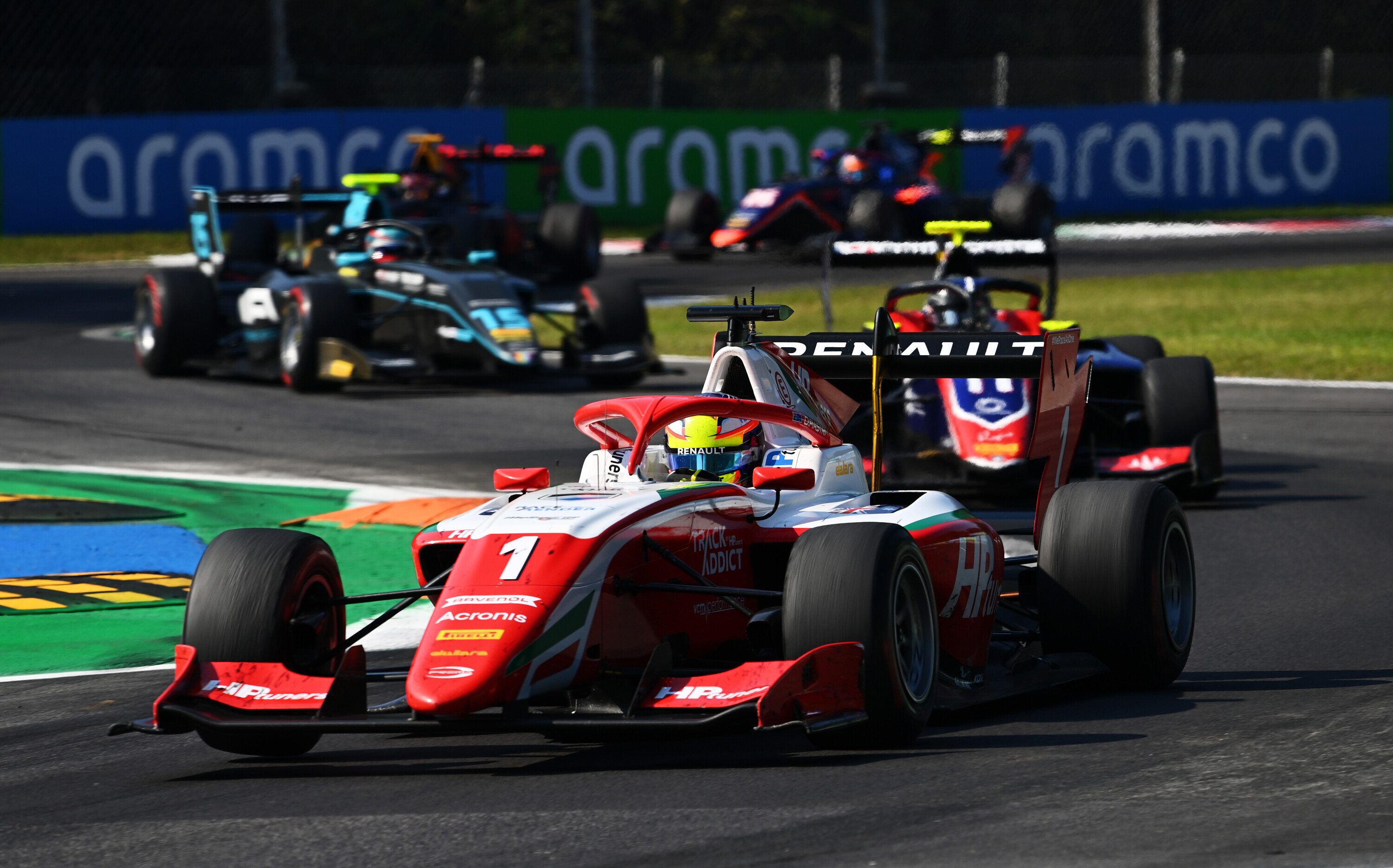Last time, it started with a phone call and culminated in a story called Convoy! I wrote for CAR (the magazine I was editing in London) and Wheels’ sister magazine, Sports Car World. It told how four of us drove a Countach, Silhouette and Urraco flat out from the Lamborghini factory to England.
First published in the March 2017 issue of Wheels magazine, Australia’s most experienced and most trusted car magazine since 1953
On a Thursday afternoon in October 1976, Roger Phillips, the UK’s Lamborghini importer, phoned to say he was flying to Italy with two pals (Steve Brazier and David Jolliffe) to collect three Lamborghinis for the Earl’s Court Motor Show. If I got to Heathrow in two hours I could join in.
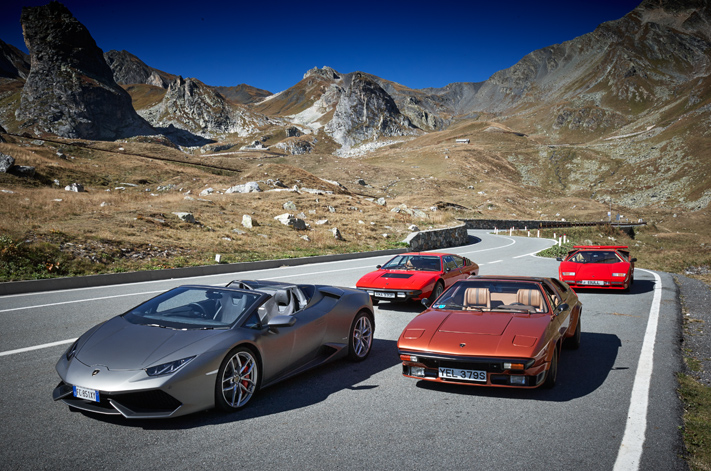
We fired up the Lamborghinis at six the next morning. They were properly warm when we struck the D979 that swoops in and out of the River Ain valley. It’s the kind of road you dream about. And that day it was magical: mist turned the valley below us silver, and as we zoomed down we stayed nose-to-tail, windows open, relishing the thunder of a 4.0-litre V12 and two 3.0-litre V8s – 28 cylinders, 12 camshafts, 14 Webers and eight exhausts – bouncing off the banks in the still air. It was an anthemic prelude to the glories ahead.
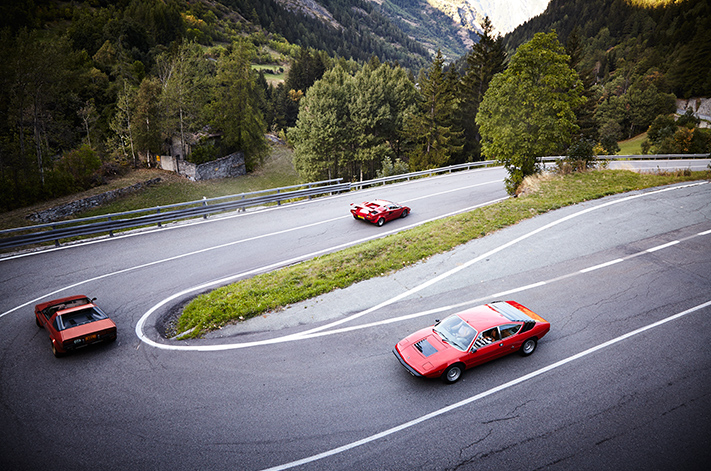
We stopped at the next service area. He pulled in, sauntered over, nodded hello and admired the cars. Two more bike cops did the same and then a group of gendarmes from a bus came over to look. Word was spreading, but we knew we were going to be okay. France was still without motorway speed limits and the cops’ demeanour said “fair enough, chaps”.
After breakfast, we accelerated away and gobbled the long, lazy curves where the A6 climbs through the Cote-d’Or’s soft hills. While David was driving the Urraco, I took the picture of its speedo on 160mph (258km/h) from the passenger’s seat, with the Silhouette and Countach drifting along ahead. It was a surreal experience seeing those dramatic bronze-gold shapes glittering in the sun as they ate the empty pale grey ribbon of motorway and speared into the blue of that Sunday morning.

Roger Phillips: “We were lucky to be in the right place at the right time. It was truly epic.”
THIS time, it begins with Silhouette owner Richard Head. At his house near London, he re-reads the Convoy! story and realises it was 40 years ago. Over a bottle of red, Richard and fellow Lamborghini enthusiast Alan Robb hatch a plan for a re-run with a Countach, Silhouette and Urraco. Alan is after-sales manager for Super Veloce Racing, a high performance car sales, service and events company outside London. Alan emails me, starts talking to Lamborghini owners keen to participate, and we put together a plan for Convoy! 2.
We need a different route. In 1976, the fastest way was through the Mont Blanc Tunnel to Geneva, then west to Nantua and along the D979 to Bourg-en-Bresse for the A6 at Macon, and on north via Paris to Calais. Now, there are several all-motorway options. We want as many miles on pristine roads as possible – and I have two in mind. Peter Robinson, my friend who lived in Italy for 16 years, reckons the SP85 up to Monte Bondone, near Trento, is Italy’s best driving road. And those epic opening scenes with the Miura in The Italian Job were filmed on the SS27 Colle del Gran San Bernardo north of Aosta. Irresistible.
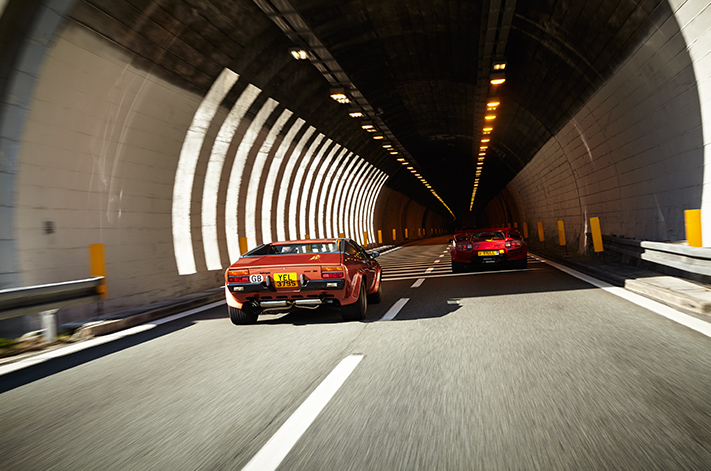
They say bad things happen in threes. Before we get to Sant’Agata Bolognese, we lose the first of the cars, Tadek and Verna Lipinski’s Countach. A coil lead has started arcing. A recovery truck takes it to former Lamborghini engineer Vigorito Biagio’s garage Autofficina Bielle. Then the front brakes on Richard Head’s Silhouette start binding; and the very moment we reach the factory, Chris and Sandra Notley’s Urraco dumps its clutch fluid. Old cars…

Meanwhile, we have a date with a road 200km north, the SP85. The Huracan, Diablo, Murcielago, and Espada head for Riva del Garda, our base for the SP85 jaunt. As we sit down to dinner, we hear the Countach arrive. One back, two to go.
Next morning, the SP85 shows us its delights – a 60km mix of visually clear hairpins, zigzag sequences and fast open bends interspersed with straights. We soon have the stirring sight of the Countach, its exhausts spitting sparks on the over-run, hounded by the thunderous Diablo and sinister Murcielago, braking hard into the bends, squatting onto their fat rear tyres to power out and bolt through the gears to triple-digit (mph) speeds.

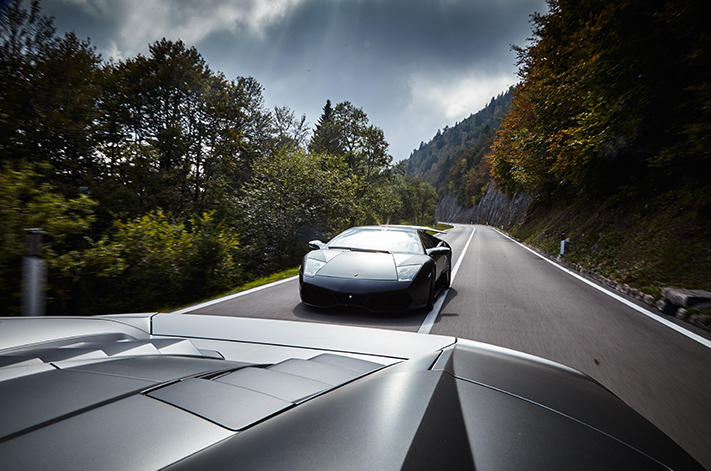
But it is coming back from the top of SP85, on the 18km-long stretch that’s been one of Europe’s best hillclimbs since 1925, that I learn what the Huracan is about. Switching the ANIMA setting from Strada to Sport sharpens the engine mapping, seven-speed gearbox, Haldex all-wheel drive, steering and stability-control systems. The exhaust note snaps to spine-tingling, with fortissimo pops and crackles on the over-run, and ferocious ‘toe-and-heel’ blips on the downshifts.
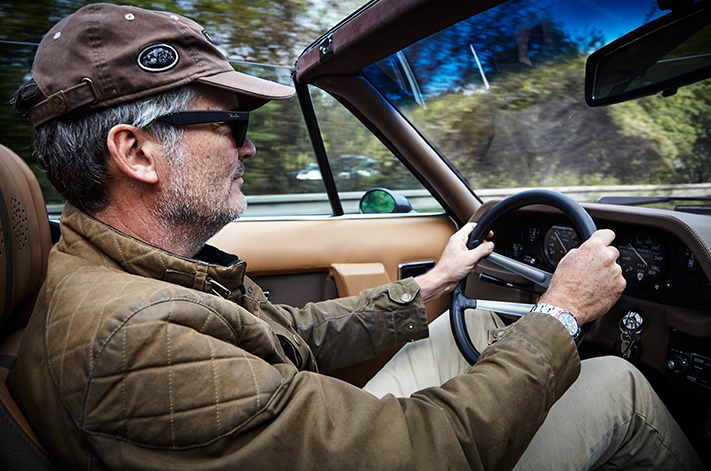
For a while, I flick the paddles manually but, frankly, I can’t do it as fast or perfectly as the system itself. It is very different from driving an old-school manual like the Countach or SE30. Without time to shift so often, you stay in second or third and utilise the V12’s huge flexibility and engine braking. Same in the V8s had they been here.
Life with a Lamborghini Huracan
I’d been mindful of comments that early Huracans understeered. With the Spyder’s introduction, Lamborghini recalibrated the front-rear torque split. In Strada, the settings are still towards understeer but I’m not getting run-out at the nose.
The grip at both ends matches the speed and power and the Huracan flows around accurately. In Sport, where Lamborghini anticipates a higher level of driver skill and desire for fun, the attitude will tighten to the verge of oversteer, and if there’s enough room and power the tail will move. But not much.
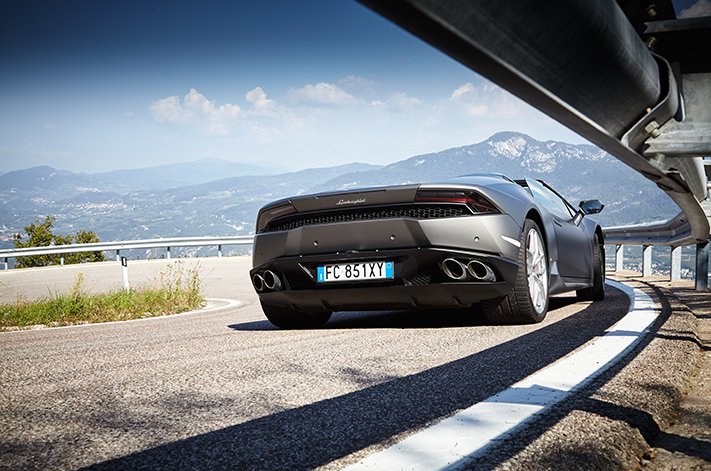
Back in the bar, Nick Tranter reckons it was the best day’s driving he’d ever had. He’s discovered new aspects of his 386kW Diablo SE30. “Given the Diablo’s size, the thing that surprised me,” he says, “was how nimble it was through the hairpins and how quickly it restored balance under full power out of them.
That huge whoomph of torque kicked in early and stayed there all the way to the limiter. Second’s versatility was fantastic for acceleration and engine braking – so different from moderns like the Huracan or my Porsche 991 Turbo, which would have gone up several gears on the short straights too. It’s an analogue experience versus a digital experience.” Glenn Brooks in the Murcielago SV, with its paddle shifts, was using the gears more as he laid down all of his car’s 493kW and, not surprisingly, found it just as soul-stirring.
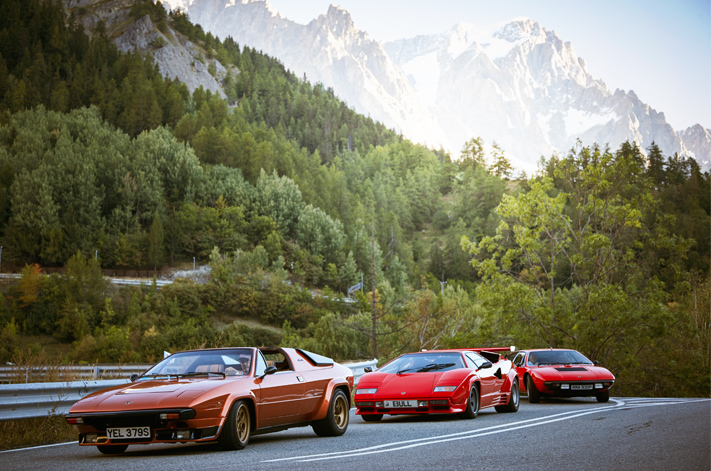
High up, its bends are so compressed the Huracan’s speed is governed by how fast I can spin the wheel from lock to lock. There’s little feel in the electric steering but its variable ratio seems to match it to each corner, with always enough lock on hand. In the tunnels on the way up and down, the rich orchestration of the V8s, V10 and V12s is an utter delight. Sant’Agata has always understood that kind of music.
And so, next day, to the Gran San Bernardo. If you’ve never driven it, find a reason. Linger just past Saint-Oyen where the old SS27 veers off the new T2 to the Tunnel. It’s here you’ll see the breathtaking Dardanelli Viaduct which the Miura drove across so evocatively in The Italian Job.
As we gaze down onto it from one of the SS27’s hairpins, the sound of Matt Monro singing ‘On Days Like These’ – from the film’s soundtrack – wafts down the hillside as Richard cranks up the volume on the Silhouette’s tape deck.
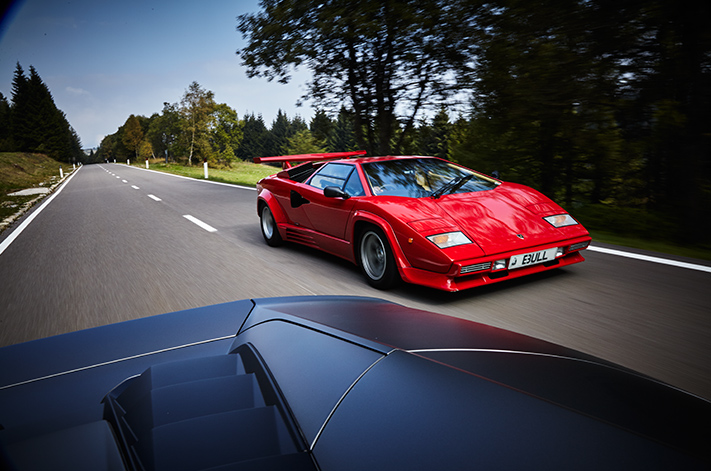
The QV’s rack and pinion, heavier than earlier Countachs’, demands muscle. The reward is fingertip-fulfilling feel. The brakes need commensurate effort. As with the SE30, the Countach stays in that monumental second gear, and occasionally third, and works up and down its rev range. With a grin, Tadek says: “It’s certainly a driver’s car; you have to keep going to the gym to have the strength to drive it on an epic road like this.”
Glenn puts Alan Robb, who rates the Murcielago SV highly, into his SV for the climb. “In Corsa, I could lean on it and use the weight to set it up through the corners,” Al says gleefully. “Left foot braking kept it balanced, either using just the grip or pushing on to get the four-wheel drive to help. At one point, it was so eager and confidence-inspiring I went into fourth and took the following corners as fast as I dared. Savouring every new push of power from the V12 on the way to the redline on that road, with no traffic and perfect weather, goes down as one of my all-time great drives.” This journey is kind of like that.
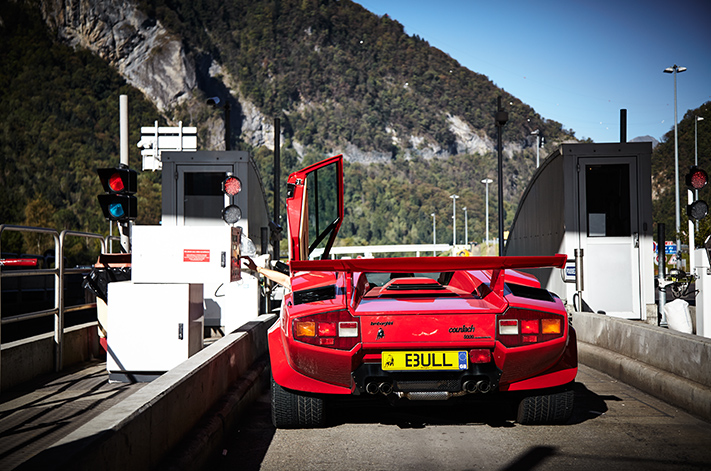
Towards Martigny the highway broadens into sequences of fast, open bends that are meat and drink to all the cars, but especially the V8s. They always were most impressive in these conditions. “The Silhouette is awesome on those sweepers and responds so well to being driven hard,” Richard reckons. “I needed to pinch myself: in front of me was a Urraco and behind me a Countach, and we are in the Alps.”
There are interesting differences and similarities between the Urraco and the Silhouette developed from it: lighter steering in the Urraco on conventional Michelins against the Silhouette’s Pirelli P7s; meatier feel in the Silhouette, a lower driving position and tighter seats; in both, modest oomph from the 3.0-litre V8 to 3500rpm then a brisk climb to the 186kW power peak at 7500rpm.
Strong directional stability, comfortable ride and clean, dependable handling. Chris Notley, able to stretch his Urraco’s legs for the first time, says: “It surpassed our expectations. It’s an elegant, remarkably comfortable and surprisingly quick and economical sports grand tourer.” Our run finishes on the Route de la Forclaz/D1506 from Martigny to Chamonix, another cracker that provides the perfect ending to a perfect day.
And then it is the 1030km haul to Paris, with the D979 on the way. Now that you encounter barely a car or truck there, it’s hard to imagine how busy this road was before the Autoroute des Titans bypassed it to and from the Mont Blanc Tunnel.
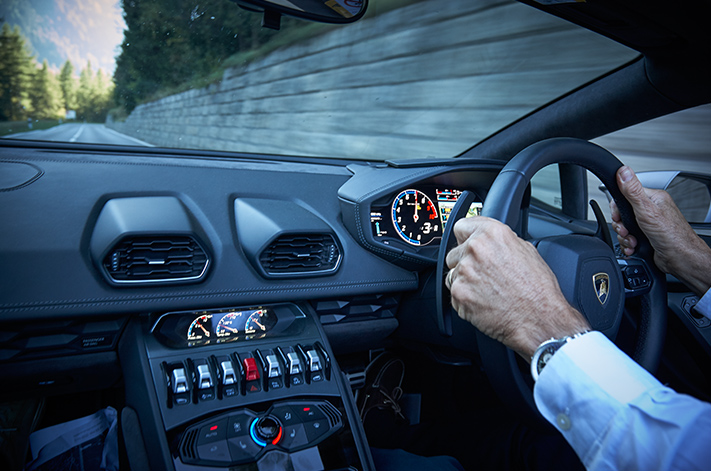
It’s properly fast and its Piattaforma Inerziale control system lets you access its pace with extraordinary ease. The three accelerometers and three gyroscopes shoot real-time high-speed data about roll, pitch and yaw to the ESC, AWD, dampers and steering systems. Lamborghini’s R&D boss Maurizio Reggiani says it lets the car get close to the point of no return while checking and controlling its attitude.
I like being able to drive as fast as I can with that kind of confidence, while having the option to switch off the ESC and get physical if I feel like playing. Down this amazing road into the Ain Valley, there is an inhibitor though: under brakes to the apex in the tighter hairpins, the pan under the nose scrapes the bitumen. A dashboard switch lifts the height for car parks and speed humps.
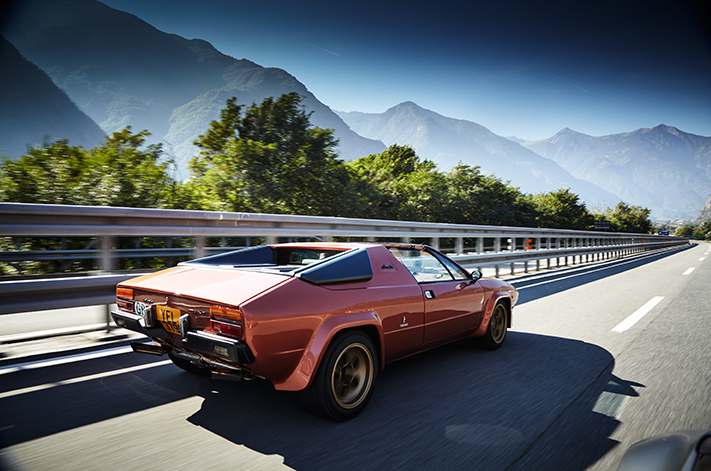
But I do have the seat against the firewall, so taller drivers mightn’t be so comfortable. All this makes long stretches like the run up the A6 to Paris a pleasure. Loping along near Beaune, I smile when I see in the mirror a low, wide shape closing fast. It could only be an Espada. Richard and Lynne Bull’s immaculate Series III sweeps past. It is in its metier. Earlier in 1976, I’d tucked away 1700km in 11 hours in an Espada and know full well its ability on open roads.
After a night at Versailles, we have just the 300km run up the A16 to Calais. Again, we are lucky: once we clear Paris, there is little traffic and all of us can enjoy long-legged cars running freely.
While we wait for the Eurotunnel train, I go over the fuel consumption. On the day that the trip computer said the Huracan had maxed at 268kph, its consumption was 12.7L/100km. Overall, it is 12.1. Pretty impressive.
Most of the crew agree it’s been their best week’s driving. With the original Convoy! trip in my memory bank, could I say that?
This was a less intense experience with more variety in a different kind of Lamborghini. Far more powerful than even the Countach, very much faster, and notably more refined – and with a touch of the Urraco’s sweetness – the Huracan Spyder gave me a week of total, unalloyed joy. I only wish it had a bigger boot in the nose for more than two small carry-ons, and better cabin storage. It’s so liveable in every other way, an admirable combination of grand tourer and hillclimb eater.
When I switch off in London after 2345km, I’m left with nothing but a hunger to drive it more. The other drivers feel the same about their cars.
It’s been a hell of a week.





